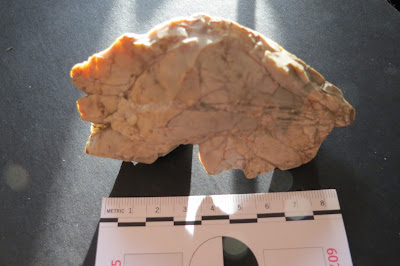Flint human head effigy, from approximately 30,000 YBP,
Aterian, north west African continent
Diverse lot of Sahara desert relics includes: 35 Neolithic, 1 Mesolithic, and 1 Paleolithic tools.
Paleolithic: An Aterian point is included in this collection, seen in the upper right. I believe this to be a hafted knife/scrapper rather than a projectile point. It is Ateria form with thick stem and rounded or abrupt tip which is worked around this way to be used for cutting or scrapping not as a tip for a projectile. This artifact dates to to approximately 30,000 years before present, at the time of the extinction of Neanderthal Man, but probably made by early Homo Sapiens Sapiens.
Neolithic: The group of 36 Sahara Neolithic relics is composed of diverse types of relics, which were discovered on ancient habitation sites deep in the western Sahara desert, mostly in the vicinity of northern Muaratania/Mali but also includes one two small basally notched Eiffel Tower points from Algeria. This group consist of several types and subtypes of projectile points from varying periods of the Neolithic era, including ovate, stemmed, triangular, and unifacial tool forms. In all there are 23 Neolithic era stone projectile points and tools, 10 hard-stone beads (mostly quartz disc beads), one hardstone celt, and a complete if a little rough cylindrical labret, this relic is thought to be used in body piercing or lips or ears.
Mesolithic: There is one unifacial blade seen at the bottom left from Morocco, dates to approximately 8,000 years before present.
-kbj










.jpg)








































